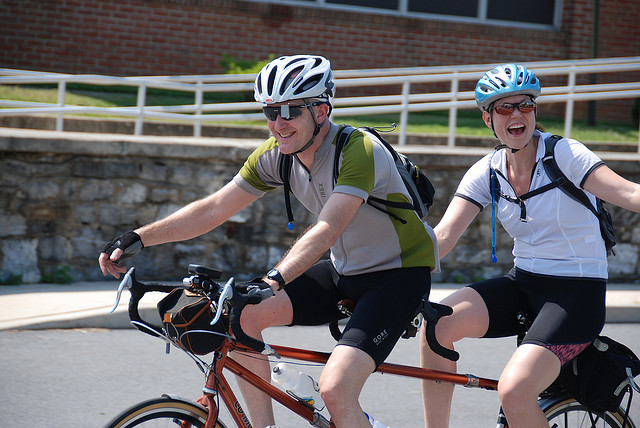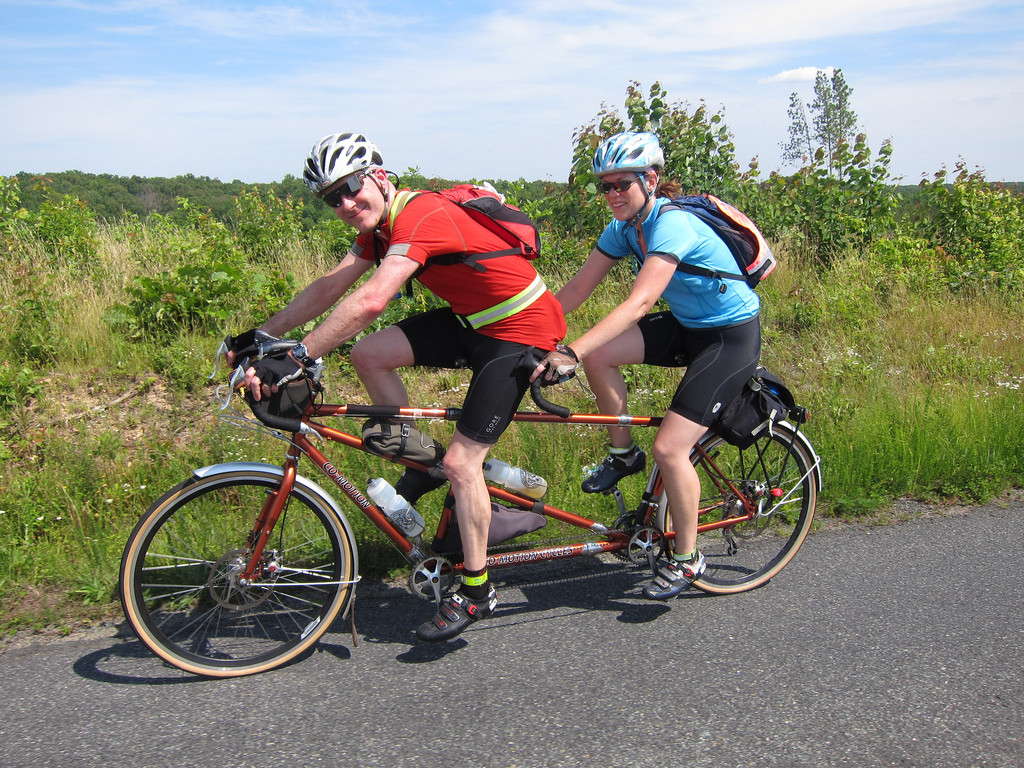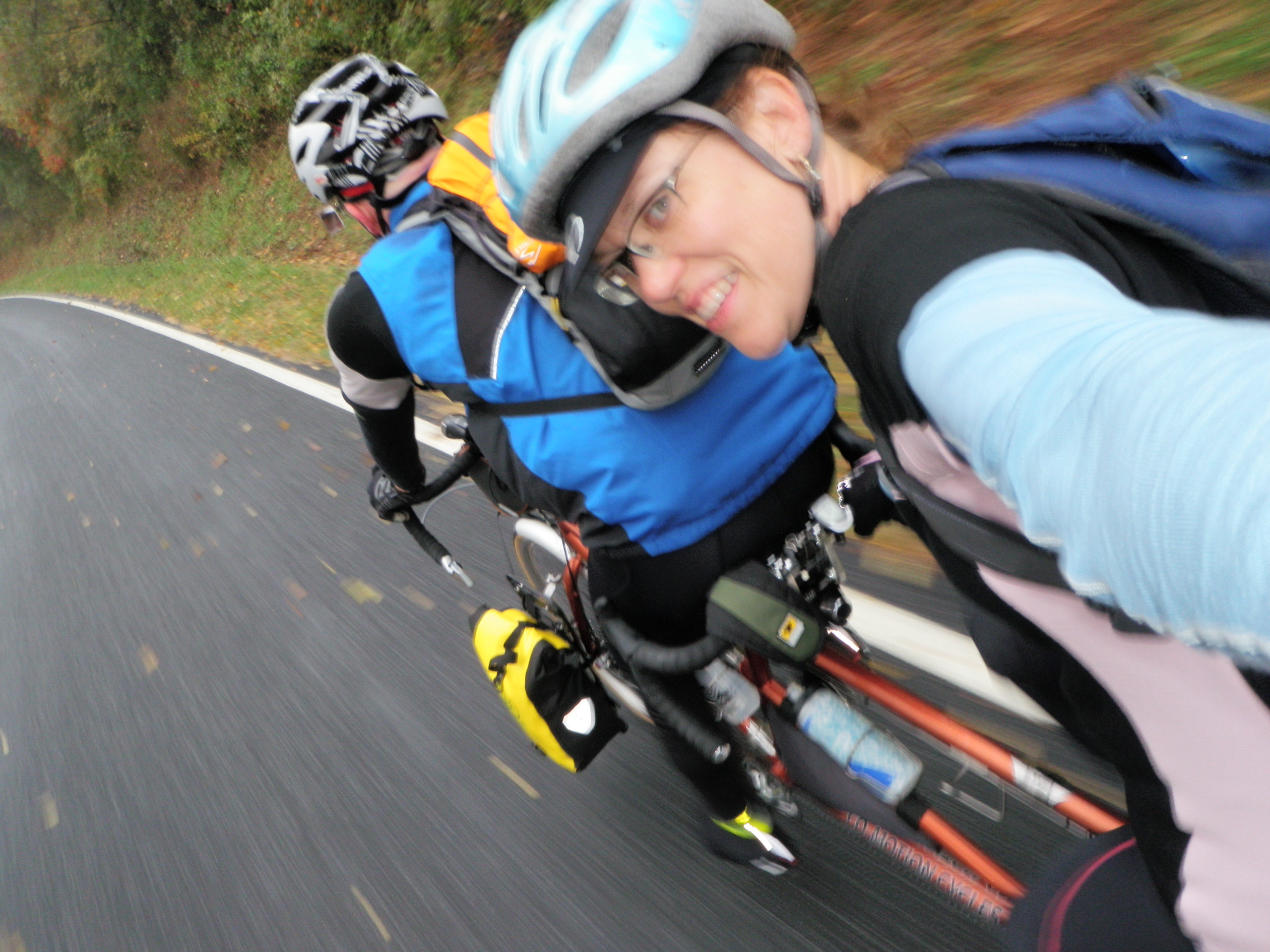Tandem bikes, those fascinating bicycles built for two, often spark curiosity and a flurry of questions. For those unfamiliar, the concept of riding in tandem can conjure up a mix of intrigue and perhaps a little bewilderment. It’s a unique way to cycle, and if you’ve never experienced it, you might find yourself wondering what it’s truly like.
Many who observe a tandem bike in action, perhaps gliding along a bike path or tackling a hill, are quick to offer their unsolicited opinions. It’s as if the very sight of two people pedaling in unison invites commentary, some of it insightful, some of it… less so. Riding a tandem seems to draw out the same kind of whimsical pronouncements you might hear about expecting parents – everyone has an idea and isn’t shy about sharing it.
However, most of these comments, though sometimes quirky, stem from a simple lack of understanding about tandem cycling. It’s not about being nosy; it’s genuine curiosity. So, to clear the air and shed some light on the tandem experience, consider this your go-to guide. Let’s address some of the common questions and dispel a few misconceptions about the world of tandem bikes.
Understanding the Roles: Captain and Stoker
In the tandem biking world, communication and teamwork are paramount, starting with understanding the distinct roles of the two riders: the captain and the stoker. The captain is always positioned at the front of the bike. Typically, this role is taken by the taller and more experienced cyclist, as they are responsible for steering, braking, and gear changes. Think of the captain as the pilot of the tandem, navigating the road ahead and making crucial decisions for both riders.
The stoker, on the other hand, sits behind the captain and focuses primarily on pedaling. Crucially, the stoker has no direct control over steering, braking, or gear selection. This necessitates a high degree of trust in the captain. The stoker must rely entirely on the captain’s judgment and anticipate their actions. Similarly, the captain depends on the stoker to maintain a steady and responsive riding position, contributing power and balance without disrupting the bike’s stability.

Captain and Stoker teamwork exemplified on a tandem bicycle.
Especially when a tandem team is just starting out, verbal cues are often essential. The captain might announce upcoming bumps, stops, or intentions to stand up to pedal. However, as the team develops a rhythm and understanding, these explicit callouts tend to fade away. Experienced tandem pairs often develop an almost intuitive sense of each other’s riding style, allowing for smoother, more synchronized rides with minimal verbal communication.
Team Compatibility: Key to a Successful Tandem Ride
For a tandem partnership to thrive, compatibility between the captain and stoker is essential. This compatibility extends beyond just getting along personally; it encompasses shared cycling preferences and riding styles. Consider these key aspects of compatibility:
-
Cadence and Spin: Riding styles vary significantly when it comes to cadence – the rate at which you pedal. Some cyclists prefer to “grind” in a larger gear at a lower cadence, while others favor a higher cadence, spinning more rapidly in a lighter gear. If one rider consistently prefers a very different cadence than the other, it can lead to discomfort and inefficiency on a tandem. Ideally, both riders should have similar cadence preferences, or at least be willing to compromise and find a comfortable middle ground.
-
Stopping and Starting Habits: On a solo bike, you can stop for a breather or admire the view whenever the mood strikes. Tandem riding requires more coordination. If one rider prefers to minimize stops and power through a ride, while the other enjoys frequent breaks, it can create friction. A successful tandem team needs to agree on the frequency and duration of stops. This is particularly important for longer rides or tours. Shared expectations regarding breaks, meal stops, and sightseeing pauses are crucial for harmonious tandem cycling.
-
Distance Goals: Before embarking on a tandem ride, especially a longer one, it’s vital for both riders to be on the same page regarding the intended distance. Whether it’s a short 20-mile jaunt, a 50-mile ride, or a challenging brevet, agreeing on the distance beforehand prevents frustration and ensures a more enjoyable experience for both. Mismatched expectations about distance can lead to one rider feeling pushed beyond their comfort level or the other feeling held back.

Endurance tandem cycling requires compatibility and shared goals, even on long rides.
In essence, a shared understanding of the ride’s plan is paramount. Without this mutual agreement on riding style, break preferences, and distance, a tandem ride can quickly become an exercise in frustration rather than shared enjoyment. Ensuring compatibility is the bedrock of a successful and enjoyable tandem biking experience.
Tandem Bike Performance: Easier or Harder Than a Single Bike?
A common question about tandem bikes is whether they make cycling easier or harder compared to riding solo. The answer, as with many things, is nuanced and depends on the specific riding conditions. Let’s break down tandem performance in different scenarios:
-
Headwinds: Tandems shine in headwinds. With two riders positioned closely together, they present a more streamlined profile to the wind than two separate cyclists. This means the team can cut through headwinds more efficiently. The combined power of two pedaling individuals driving a single frame makes tackling windy conditions significantly less taxing than it would be for two solo riders.
-
Uphills: Hills are where tandems face their biggest challenge. While you have the combined power of two engines, you also have the combined weight of two people and a heavier bike. On steep inclines, this extra weight becomes a significant factor, making uphill climbs more strenuous on a tandem than on a single bike. For heavier teams, like the author’s example, the uphill struggle can be particularly pronounced.
-
Downhills: Downhills are a tandem’s playground. Once gravity takes over, the added weight of a tandem becomes an advantage. Tandems can achieve impressive speeds on descents. Their stability at high speeds, when well-maintained and properly handled, can be exhilarating. Experienced tandem teams often relish downhills as an opportunity to really “roll,” as the author playfully puts it, sometimes reaching impressive speeds.
-
Rollers: Rolling terrain, characterized by short, moderate hills, can be surprisingly tandem-friendly. The momentum gained on a downhill section can often carry the tandem partway or even to the top of the next incline. This “momentum effect” can make riding through rolling hills quite enjoyable and less energy-sapping than constantly accelerating and decelerating on a solo bike.

Navigating varied terrain on a tandem bike presents unique advantages and challenges.
In summary, tandem bikes offer performance advantages in headwinds and on downhills, while uphill climbs can be more challenging. Understanding these performance characteristics helps tandem teams adjust their riding style and choose routes that play to their strengths.
Debunking Myths: The Stoker Can’t Take a “Free Ride”
One persistent myth about tandem bikes is that the stoker can occasionally stop pedaling without the captain noticing, essentially getting a “free ride.” This is definitively false. The reality is that the captain will immediately sense any lapse in the stoker’s pedaling effort.
When the stoker stops pedaling, the captain feels an immediate increase in resistance. It’s as if the bike suddenly becomes harder to pedal, forcing the captain to work harder or shift to an easier gear to compensate. Conversely, if the stoker were to suddenly pedal much harder than the captain, the captain would feel “spun out,” struggling to keep up with the stoker’s increased effort.
The connection between captain and stoker on a tandem is direct and undeniable. While the stoker might sometimes become momentarily distracted, perhaps lost in thought, any significant change in pedaling effort will be quickly apparent to the captain. The author humorously describes this common experience, noting the captain’s coded inquiries like, “Are you ok back there, honey?” – a gentle but clear signal that the stoker’s contribution is being noticed (or not noticed!). Tandem riding is truly a partnership, requiring consistent effort from both riders.
Challenges and Considerations for Tandem Riders
Beyond the basic mechanics of riding, tandem cycling presents some unique challenges and considerations:
-
Night Riding for the Stoker: Night riding can be a more mentally demanding experience for the stoker. In dark, rural environments with no ambient lighting, the stoker’s forward vision is completely blocked by the captain. Peripheral vision is also limited by the darkness. This lack of visual input can be unsettling for some stokers. A clear, starry night can offer some visual relief, allowing the stoker to look upwards and find a sense of orientation, but overall, night riding requires a greater degree of trust and mental fortitude from the stoker.
-
The Captain’s Draft and Stoker’s Protection: Aerodynamically, the stoker benefits from the draft created by the captain, who bears the brunt of the wind resistance. This draft effect can be a significant advantage for the stoker, especially in cooler weather. In winter or on chilly days, the stoker can often get away with wearing fewer layers than the captain and experiences less wind chill on their face. However, in hot summer conditions, this draft effect can become a disadvantage. The area behind the captain can become a zone of trapped heat, making the stoker feel significantly warmer than the captain. Stokers need to be mindful of this and adjust their clothing accordingly to avoid overheating.
Beyond Romance: The True Essence of Tandem Riding
While tandem bikes might sometimes be perceived as “cute,” “sweet,” or “romantic,” especially when ridden by couples, these adjectives often fall short of capturing the true essence of tandem cycling. After a long, challenging ride, particularly distances exceeding 100 miles, terms like “bad@$$” and “accomplished” are likely to be more fitting.
The real reward of tandem riding lies in the profound sense of teamwork and synchronization it fosters. When a long ride goes well on a tandem, it’s a testament to the successful partnership between captain and stoker. It signifies that both riders have effectively synced their efforts, communicated seamlessly (verbally or non-verbally), and worked together to overcome challenges. This shared accomplishment, the feeling of conquering a distance or a tough route as a unified team, is a uniquely exhilarating aspect of tandem biking, far surpassing any simplistic notions of mere romanticism.
Conclusion
Tandem bikes offer a distinctive and engaging way to experience cycling. They demand teamwork, communication, and a shared sense of adventure. Understanding the roles of captain and stoker, appreciating the nuances of tandem performance in different terrains, and debunking common myths are all key to unlocking the rewarding world of tandem biking. Whether you’re considering trying a tandem bike for the first time or are a seasoned tandem team, embracing the collaborative spirit and unique dynamics of tandem cycling is sure to lead to memorable and fulfilling rides.

